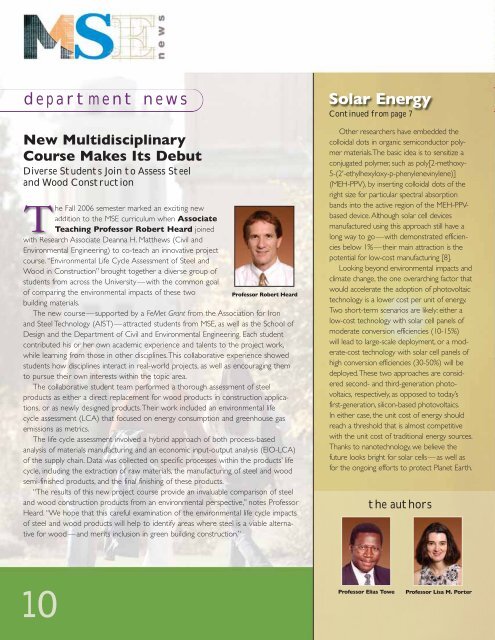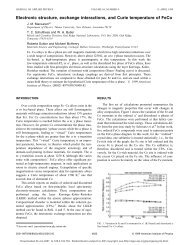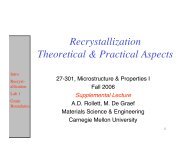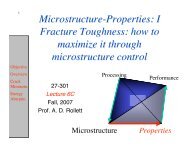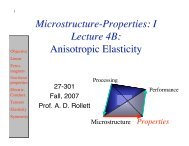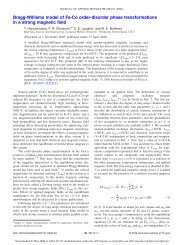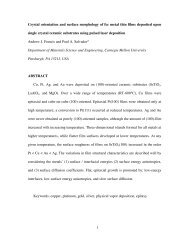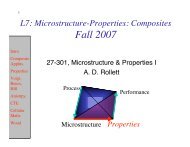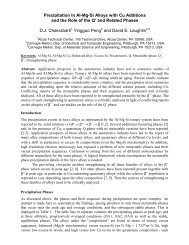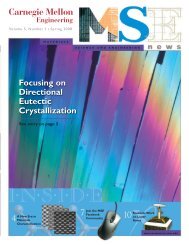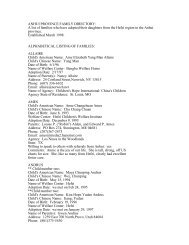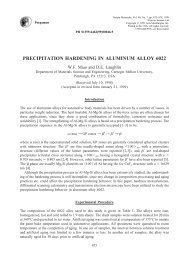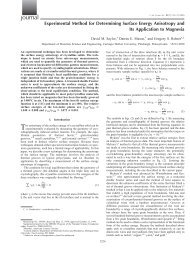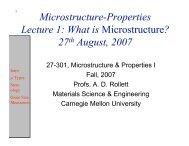Carnegie Mellon - Materials Science and Engineering - Carnegie ...
Carnegie Mellon - Materials Science and Engineering - Carnegie ...
Carnegie Mellon - Materials Science and Engineering - Carnegie ...
You also want an ePaper? Increase the reach of your titles
YUMPU automatically turns print PDFs into web optimized ePapers that Google loves.
department news<br />
New Multidisciplinary<br />
Course Makes Its Debut<br />
Diverse Students Join to Assess Steel<br />
<strong>and</strong> Wood Construction<br />
The Fall 2006 semester marked an exciting new<br />
addition to the MSE curriculum when Associate<br />
Teaching Professor Robert Heard joined<br />
with Research Associate Deanna H. Matthews (Civil <strong>and</strong><br />
Environmental <strong>Engineering</strong>) to co-teach an innovative project<br />
course. “Environmental Life Cycle Assessment of Steel <strong>and</strong><br />
Wood in Construction” brought together a diverse group of<br />
students from across the University—with the common goal<br />
of comparing the environmental impacts of these two<br />
Professor Robert Heard<br />
building materials.<br />
The new course—supported by a FeMet Grant from the Association for Iron<br />
<strong>and</strong> Steel Technology (AIST)—attracted students from MSE, as well as the School of<br />
Design <strong>and</strong> the Department of Civil <strong>and</strong> Environmental <strong>Engineering</strong>. Each student<br />
contributed his or her own academic experience <strong>and</strong> talents to the project work,<br />
while learning from those in other disciplines. This collaborative experience showed<br />
students how disciplines interact in real-world projects, as well as encouraging them<br />
to pursue their own interests within the topic area.<br />
The collaborative student team performed a thorough assessment of steel<br />
products as either a direct replacement for wood products in construction applications,<br />
or as newly designed products. Their work included an environmental life<br />
cycle assessment (LCA) that focused on energy consumption <strong>and</strong> greenhouse gas<br />
emissions as metrics.<br />
The life cycle assessment involved a hybrid approach of both process-based<br />
analysis of materials manufacturing <strong>and</strong> an economic input-output analysis (EIO-LCA)<br />
of the supply chain. Data was collected on specific processes within the products’ life<br />
cycle, including the extraction of raw materials, the manufacturing of steel <strong>and</strong> wood<br />
semi-finished products, <strong>and</strong> the final finishing of these products.<br />
“The results of this new project course provide an invaluable comparison of steel<br />
<strong>and</strong> wood construction products from an environmental perspective,” notes Professor<br />
Heard. “We hope that this careful examination of the environmental life cycle impacts<br />
of steel <strong>and</strong> wood products will help to identify areas where steel is a viable alternative<br />
for wood—<strong>and</strong> merits inclusion in green building construction.”<br />
10<br />
Solar Energy<br />
Continued from page 7<br />
Other researchers have embedded the<br />
colloidal dots in organic semiconductor polymer<br />
materials. The basic idea is to sensitize a<br />
conjugated polymer, such as poly[2-methoxy-<br />
5-(2'-ethylhexyloxy-p-phenylenevinylene)]<br />
(MEH-PPV), by inserting colloidal dots of the<br />
right size for particular spectral absorption<br />
b<strong>and</strong>s into the active region of the MEH-PPVbased<br />
device. Although solar cell devices<br />
manufactured using this approach still have a<br />
long way to go—with demonstrated efficiencies<br />
below 1%—their main attraction is the<br />
potential for low-cost manufacturing [8].<br />
Looking beyond environmental impacts <strong>and</strong><br />
climate change, the one overarching factor that<br />
would accelerate the adoption of photovoltaic<br />
technology is a lower cost per unit of energy.<br />
Two short-term scenarios are likely: either a<br />
low-cost technology with solar cell panels of<br />
moderate conversion efficiencies (10-15%)<br />
will lead to large-scale deployment, or a moderate-cost<br />
technology with solar cell panels of<br />
high conversion efficiencies (30-50%) will be<br />
deployed. These two approaches are considered<br />
second- <strong>and</strong> third-generation photovoltaics,<br />
respectively, as opposed to today’s<br />
first-generation, silicon-based photovoltaics.<br />
In either case, the unit cost of energy should<br />
reach a threshold that is almost competitive<br />
with the unit cost of traditional energy sources.<br />
Thanks to nanotechnology, we believe the<br />
future looks bright for solar cells—as well as<br />
for the ongoing efforts to protect Planet Earth.<br />
the authors<br />
Professor Elias Towe Professor Lisa M. Porter


